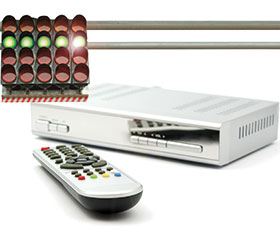

Set-top boxes (STB) for South Africa’s long awaited migration from analog to digital terrestrial television (DTT) broadcasts are finally rolling off production lines. Although it’s far from the promised flood at this stage, it at least comes as a welcome development to the three companies selected for government’s first batch order: Leratadima, CZ Electronics and BUA Africa.
Also welcoming are the households in the SKA (Square Kilometre Array) area of the Northern Cape which were given free STBs just in time for Christmas, as part of government’s plan to provide five million free STBs to the country’s poorest households. Following the launch of the first decoders by the minister of communications, Faith Muthambi, to three households in Keimoes and three in Kakamas on 17 December, the SA Post Office (SAPO) commenced delivery of the first batch of 2000 units.
In a speech delivered at the launch, Muthambi stated “We have reached a significant milestone in the realisation of the implementation programme. It is where ordinary South Africans start to enjoy the benefit of the evolution of the television system in the country.” The week prior to this saw Cabinet approve the start of dual-illumination in the digital migration process.
“Today’s campaign places emphasis on connection,” Muthambi continued. “The South Africa Go Digital encourages everyone to embrace digital migration to move South Africa forward. The Broadcasting Digital Migration platform’s biggest selling point is that it offers more choice of programming, greater access and better quality while using less bandwidth.
“Our milestone signals that we are firmly on our path to achieving our digital migration goals. I encourage all those who qualify for free DTT devices to visit their nearest South African Post Offices to register so that they too can enjoy the benefits of this programme.”
Trevor Ndlazi, acting CEO of SAPO, urged all households in the SKA area to apply for a set-top box at their local post office. He said 2281 households in the area were due to receive an SMS from the SA Post Office requesting them to collect their set-top boxes from their nearest post office. The registration process also started in the Free State province on 1 December 2015.
South African households with a combined monthly income of R3200 or less are eligible for a subsidised set-top decoder. As part of contributing to the local communities, local contractors will be enlisted to install the satellite dish and decoder. Extra counter staff will be employed at the SAPO outlets in the Free State and Northern Cape in order to provide efficient service. Ndlazi encouraged residents in these areas to apply as soon as possible to avoid a last-minute rush.
Trials and tribulations
The DTT migration process has been mired in controversy for years, frustrating many local manufacturers which were hoping or expecting to get a portion of the STB orders. Eventually, this led to missing the 17 June 2015 deadline which was agreed to with the International Telecommunications Union (ITU). The long list of ructions that have held up the project includes government in-fighting, indecision, allegations of corruption and legal battles.
The decision to split the former Department of Communications into a new Department of Communications (with a different mandate from the original) and the Department of Telecommunications and Postal Services, each of which has a role to play in the Broadcasting Digital Migration (BDM) programme, led to a power struggle between their respective ministers, Faith Muthambi and Siyabonga Cwele. Even before this, however, the game of political hot potato over the position of communications ministers ensured that the repeated handing over of the job to a new appointee resulted in a lack of consistency in the decisions made.
Legal battles between government and free-to-air broadcasters also presented obstacles over whether or not to include an encryption system or access control in the set-top boxes. Finally, in March 2015 Faith Muthambi announced that a decision had been made to include an access control system, but not encryption.
The Universal Service and Access Agency of South Africa (USAASA), which is in charge of the tender process determining the allocation of manufacturing volumes to applicant manufacturers, was not left unscathed either. It was the target of allegations by opposition politicians as well as industry players, accusing it of making decisions that benefited certain political agendas rather than the local manufacturing industry.
Moving on is a process
The point has finally been reached where STB manufacturing has started, but there’s still going to a bit of a wait before they can be made in large volumes. For now, government is prioritising the border areas of SA, where analog TV signals have to be switched off to avoid interfering with neighbouring countries. These areas are receiving satellite-enabled decoders, which will not be required elsewhere. The same applies to the Northern Cape’s SKA area, where interference must be avoided with the Square Kilometre Array telescope systems.
The market opportunities for STB manufacturers won’t stop once the promised five million free units have been delivered, though. Citizens who want to receive DTT broadcasts and who can afford to buy one, are free to purchase a decoder through the usual consumer electronics sales channels of retail stores and online shopping (in fact, some models can already be found on store shelves). In a sense, however, all bets are off on that front, since local manufacturers are competing with foreign imports, albeit the latter are subject to import duties to enhance the competitiveness of locally made products.
| Tel: | +27 11 543 5800 |
| Email: | [email protected] |
| www: | www.technews.co.za |
| Articles: | More information and articles about Technews Publishing |

© Technews Publishing (Pty) Ltd | All Rights Reserved